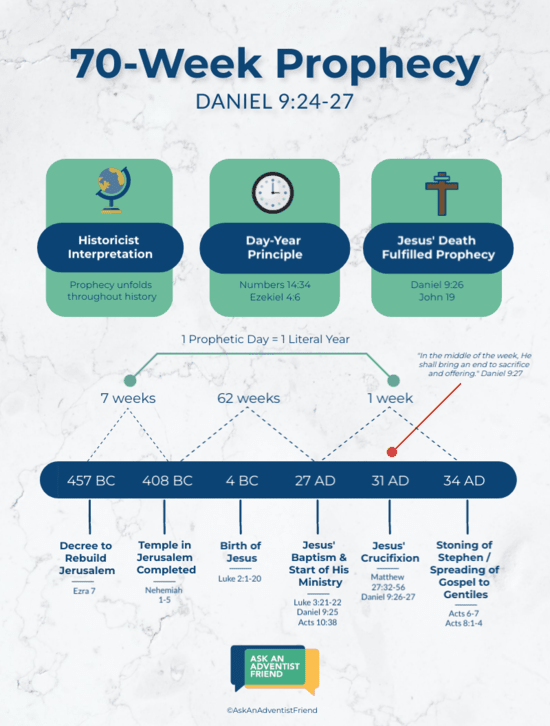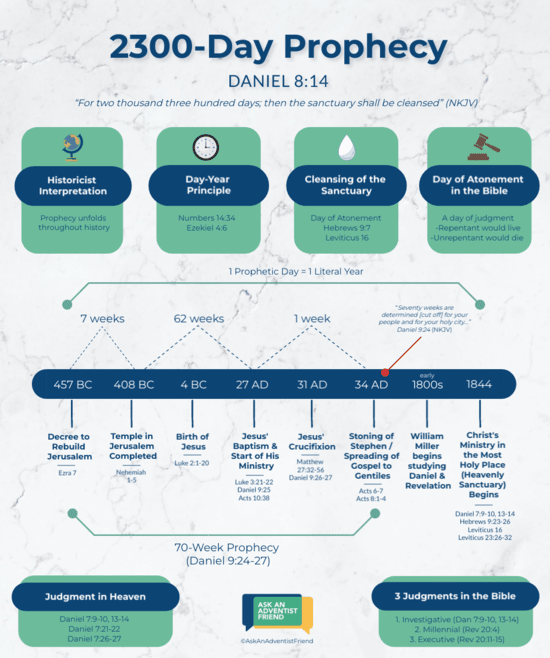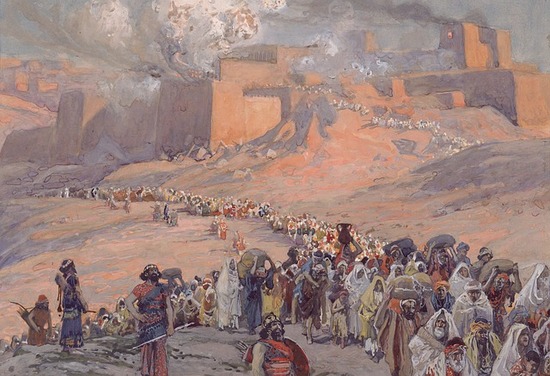All About the 2300-Day Prophecy and the Investigative Judgment
Daniel 8:14 introduces us to the longest prophetic timeline in the Bible—the 2300-day prophecy. But what could this prophecy mean? Is it even possible for us to understand it?
Understanding prophecy may not be as hard as you think. We can decode the 2300-day prophecy in the same way we might decode other prophecies in the Bible—by comparing it to other passages we find in Scripture.
In doing so, we find that the 2300-day prophecy points to the fulfillment of a special series of events from 457 BC to AD 1844, which ultimately point to the time of an event called the Investigative Judgment.
Let’s dig into the 2300-day prophecy to determine how these dates were identified, what parts of history were involved, and why.
We’ll cover:
1. What the 2300-day prophecy is
2. When the prophecy begins
3. When it ends
4. The purpose of the Investigative Judgment, and what it accomplishes
5. How the 2300-day prophecy shows what Jesus is doing for us
Let’s start by understanding what the 2300-day prophecy is, and the context behind it.
What is the 2300-day prophecy?
The 2300-day prophecy is a prophetic timeline from Daniel 8:14 that spans 2300 years, marking an important series of events for God’s people, from 457 BC to AD 1844.
Adventists have determined these dates by investigating what Scripture has to say about the beginning of this prophecy and what the Bible says about prophetic days representing years, based on the day-for-a-year principle as described in Numbers 14:34 and Ezekiel 4:5-6 (more on this later).
For now, let’s take a quick look at some backstory to this prophecy.
The context of the 2300-day prophecy
The 2300-day prophecy was given to the prophet Daniel in a vision by the angel Gabriel, as recorded in Daniel 8:14:
“For two thousand three hundred days; then the sanctuary shall be cleansed” (NKJV).
[Other Bible versions, like the ESV, NASB, etc., call them 2300 “mornings and evenings” instead of 2300 days. But these mean the same thing (days), since they each represent half of a day. And even at Creation, a day was referred to as being made of an evening and a morning (Genesis 1:1, 5, 8, 13, 19, 23, 31).]
Daniel was given this prophecy while he and some of the Jews of Judah were in captivity in Babylon. Though they were captives, God gave them hope, promising them release from captivity after a 70-year period and a better future through the prophecies He revealed to Daniel.1
This prophecy is just one of three main prophecies recorded in three different chapters in the book of Daniel—Daniel 2, 7, and 8. They all speak of the rise and fall of great world empires, which would ultimately end with the establishment of God’s kingdom at the Second Coming of Jesus.
Comparison between Daniel 2, 7, and 8
We can get a better idea of what the 2300-day prophecy means by looking at the other prophecies in the Book of Daniel.
Daniel 2
Daniel 2 predicted the rise and fall of four successive world empires, followed by the reign of God’s eternal kingdom.
These kingdoms were represented by the following symbols:2
- Gold (Daniel 2:37-38) – Babylon (626 BC to 539 BC)
- Silver (Daniel 2:39) – Medo-Persia (539 BC to 331 BC)
- Bronze (Daniel 2:39) – Greece (331 BC to 146 BC)
- Iron (Daniel 2:40-44) – Pagan and Papal Rome, then modern/divided Europe (145 BC until the Second Coming)
- Great stone (Daniel 2:44-45) – God’s eternal kingdom after the Second Coming of Jesus
Many Bible scholars and historians confirm the accuracy of this prophecy, including the Biblical Archeology Society.3
Daniel 7
Daniel 7 presents the same kingdoms using different symbols and provides further detail (Daniel 7:3, 17-18):4
- Lion (Daniel 7:4) – Babylon
- Bear (Daniel 7:5) – Medo-Persia
- Leopard (Daniel 7:6) – Greece
- Dreadful beast (Daniel 7:7, 8, 11, 19-21, 23-25) – Pagan and Papal Rome, then modern Europe that will persecute God’s people
- Kingdom of God that God’s people will possess (Daniel 7:22, 27)
But Daniel 7 adds a new element, one not found in Daniel 2.
It tells us that while the final Earthly kingdom reigns just before the kingdom of God is set up at the Second Coming, there will be a judgment in heaven to determine who will be made citizens of God’s eternal kingdom.
The judgment is highlighted three times:
- Daniel 7:9-10, 13-14
- Daniel 7:21-22
- Daniel 7:26-27
The time of this judgment is referred to in Daniel 8 in the 2300-day prophecy.
Daniel 8
This vision picks up the same sequence of world empires. But it leaves out Babylon and starts with Medo-Persia, probably because the Babylonian empire was about to be conquered and the supremacy would soon shift to the Medo-Persian kingdom (Daniel 5:30; 8:1).5
- Ram – Medo-Persia (Daniel 8:3-4, 20)
- Goat – Greece (Daniel 8:5-8, 21-22)
- Little horn – Rome, a powerful political empire that reigns after Greece. It’s considered blasphemous because it discredits God’s sanctuary system and persecutes God’s people.
This kingdom will exist until the end of time, when it will be destroyed “without human means” (Daniel 8:9-12, NKJV; Daniel 8:23-25, NKJV).
Its destruction will mirror the destruction of the worldly kingdoms spoken of in Daniel 2:34-35, 44-45. And its fall will bring in the reign of God’s kingdom.
In the end, the three prophecies of Daniel all point to the same prediction. The following chart shows us how they all complement each other:
| Daniel 2 | Daniel 7 | Daniel 8 |
| Babylon | Babylon | ——————- |
| Medo-Persia | Medo-Persia | Medo-Persia |
| Greece | Greece | Greece |
| Rome | Rome | Rome |
| ——————– | Judgment in heaven | Sanctuary cleansed |
| God’s kingdom | God’s kingdom | ——————- |
So how long will the little horn continue to reign? How long will this religious and political power persecute God’s people and desecrate the temple?
The 2300-day prophecy in Daniel 8:14 gives us the answer.
It tells us that after 2300 days, the sanctuary will be cleansed (Daniel 8:14). And this cleansing will bring an end to the little horn’s rule.
Though the cleansing of the sanctuary seems to be the climax in the prophecy of Daniel 8, the angel Gabriel doesn’t tell Daniel when the 2300 days begin or end. But he specifies that this vision concerns the time of “the end” (Daniel 8:17, NKJV).
He says:
“And the vision of the evenings and mornings which was told is true; therefore seal up the vision, for it refers to many days in the future” (Daniel 8:26, NKJV).
Daniel is understandably blown away by this revelation, and, like many of us, wants to know more. He wants to know when this prophecy will take place (Daniel 8:27, NKJV).
So in Daniel 9, angel Gabriel returns to help him understand it.
When does the 2300-day prophecy begin?
Adventists have determined that the 2300-day prophecy timeline began in 457 BC, based on our study of the 70-week prophecy in Daniel 9:24-27.
The 70-week prophecy
 The 70-week prophecy has to do with the Jewish nation, from the restoration of Jerusalem after the Babylonian captivity until a little after the coming of the much-awaited Messiah.
The 70-week prophecy has to do with the Jewish nation, from the restoration of Jerusalem after the Babylonian captivity until a little after the coming of the much-awaited Messiah.
It was delivered to Daniel after the Medo-Persian empire overthrew Babylon and after Daniel discovered the end of the Jews’ captivity was near. It was given in answer to Daniel’s prayers that God deliver his people from captivity and help them restore Jerusalem.
This prophecy also serves to answer Daniel’s questions about a prophecy, presumably the 2300-day prophecy, as that’s the last prophecy the book of Daniel mentions that Daniel longs to understand.
As Daniel is praying and fasting, the angel Gabriel appears to him and says:
“O Daniel, I have now come forth to give you skill to understand … therefore consider the matter, and understand the vision” (Daniel 9:22-23, NKJV).
The angel Gabriel begins the prophecy by telling Daniel, “Seventy weeks are determined for your people and for your holy city…” (Daniel 9:24, NKJV).
The word “week” here is translated from the Hebrew word shabua, which means seven consecutive days.6 So we understand that 70 weeks refers to 490 days.
And the word “determined” is translated from the word chathak, which means “to cut off.”7
So the 490 days are cut off…from what?
Given its context, we can safely infer that this shorter time period is cut from the longer time period of 2300 days.
This time period gives Daniel an answer for when the Jews will be released from captivity, just as it gives us insight into the 2300-day prophecy.
The angel tells Daniel that during the 490 days, the Jews will carry out several reforms and rebuild Jerusalem in a way that they will function as an independent religious and civic unit. And the end of it will see the baptism and death of the Messiah, and the spread of the Gospel to the Gentiles.
But Gabriel doesn’t stop there. He goes ahead and gives the specifics of the prophecy’s starting point. He says:
“Know therefore and understand, that from the going forth of the command to restore and build Jerusalem until Messiah the Prince, there shall be seven weeks and sixty-two weeks; the street shall be built again, and the wall, even in troublesome times” (Daniel 9: 25, NKJV).
So the 2300-day prophecy begins with the command or decree to restore and rebuild Jerusalem. And there are 69 weeks (483 days) between this decree and the year Jesus, the Messiah, begins His ministry.
So when was this decree that marks the beginning of the 490 days given?
A look at historical records in the book of Ezra shows that three decrees were given by various Medo-Persian kings:8
- The first by King Cyrus in 537 BC (Ezra 1:1–4)
- The second by King Darius I around 520 BC (Ezra 6:1–12)
- The third by King Artaxerxes in the autumn of 457 BC (Ezra 7:1–26)
Of these three decrees, the third is the only one that allowed the Jews to completely restore Jerusalem and operate as an autonomous state within the Medo-Persian empire.
This means the 2300-day prophecy and the 70-week prophecy both started in 457 BC
But taken as literal time, 70 weeks is roughly one year and four months. That’s not long enough to get from the time of the decree, the fifth century BC, to the time of the Messiah, Jesus, who came in the first century AD.
This is where the day-for-a-year principle, a method the Bible gives us for interpreting prophetic timelines, comes in.
Day-for-a-year principle
The day-year principle explains how a day in biblical prophecy symbolizes a year in literal time. It’s also referred to as the “year principle.”
Its basis in Scripture is found in passages like:
- Numbers 14:34—God told the Israelites they would wander in the wilderness for 40 years, with every year representing each day that the spies spent in Canaan (Numbers 13:25).
- Ezekiel 4:5-6—God commanded the prophet Ezekiel to lie down on his left side for 390 days, and then on his right side for 40 days to symbolize the number of years God would punish Israel (390 years) and Judah (40 years).
The day-year principle has a solid biblical and historical foundation. It was used by both Jewish and Christian interpreters throughout church history. It was also common for Protestant reformers to interpret prophecy with the historicist school of thought, or the idea that prophecy is tied to historical events.9
Examples of these include Jewish writings like The Book of Jubilees and Seder Olam, Bible historians Tichonius and Benjamin Ben Moses Nahawendi, and the reformers Philipp Melanchthon and Martin Luther.10
By using the day-year principle, we can understand that the 409 days of the 70-week prophecy actually represent 490 years. And if counted from 457 BC, we get to AD 26 in 483 years.
But there’s another layer to this puzzle. We have to account for the “0” year when we shift from BC to AD (as you would on a number line). This requires us to add an extra year, which gives us the year AD 27. It’s the year Jesus is historically believed to have been baptized, marking the beginning of His public ministry on earth before His death on the cross.
Then if we add the remaining 7 years (to make it 490 years), we get to AD 34—the end of the prophecy.
Now that we have ascertained the fall of 457 BC as the starting point of the 2300-day time prophecy, let’s look at when it ended and the circumstances around that time.
When does the 2300-day prophecy end?
 Adventists believe the 2300-day prophecy ended in the fall of AD 1844. Here’s how we arrived at this date:
Adventists believe the 2300-day prophecy ended in the fall of AD 1844. Here’s how we arrived at this date:
Using the year-day principle, we have 2300 years for the 2300 days. Counted from 457 BC, we get to the year 1843.
But again, considering the “0 year” when shifting from BC to AD, we have to add an extra year to the count to make it 1844.
Fall 457 BC … 2BC, 1BC, 1A.D, 2AD … Fall 1844 AD
And because the decree by Artaxerxes was given in the fall of 457 BC, the end of the 2300 years also falls in the fall of 1844.
So what would happen in the fall of 1844?
From the text in Daniel 8:14, we read that the sanctuary would be restored, or as the King James and New King James versions put it, “cleansed,” at the end of the 2300 years.
This word “cleansed” comes from the Hebrew root word nisdaq, which means to be put right. Or to be made clean, restored, and vindicated.11 Many other modern translations reflect that.
And as we saw in the sequence of events in history that involved the rise and fall of nations depicted in Daniel 2, 7, and 8, the cleansing of the sanctuary in Daniel 8 parallels the judgment in heaven in Daniel 7. As a matter of fact, the cleansing of the sanctuary and the judgment are the same thing. They represent the same event, just as different symbols in different chapters of Daniel represent the same empires.
So what does the cleansing of the sanctuary mean? We have to look for passages that describe this event to find out.
In the Bible, there is only one occasion when the sanctuary (temple) was cleansed—on the Day of Atonement.
What happened on the Day of Atonement?

Photo by Edgar Chaparro on Unsplash
The Day of Atonement was a day when the sins of the Israelites—which were transferred to the sanctuary all year through animal sacrifices—were ceremonially cleansed.
It happened on the tenth day of the seventh month, at the end of the Hebrew calendar (Leviticus 16:29, 34).
It was considered a Sabbath, where no one would do any work and everyone in Israel was to confess their sins (Leviticus 23:32).
The rituals of the day are described in Leviticus 16. It was a day when the sins of the Israelites that had been transferred to the sanctuary through sacrifices throughout the year were finally cleansed from the sanctuary.
This was the only day in a year when anyone (the high priest) entered the Most Holy Place in the sanctuary (Hebrews 9:7).
The high priest would first atone for his own sins and the sins of his household in the Most Holy place by offering a bull as a sin offering (Leviticus 16:11-14).
Then he would atone for all of Israel by bringing two goats before God in the sanctuary. He would then cast lots and pick one to be sacrificed for the sins of Israel, and the other to serve as the “scapegoat.” The blood of the live goat would be sprinkled in the Most Holy Place, at the Mercy Seat, and on the altar for the sins of Israel (Leviticus 16:7, 8, 15-18).
All this to “cleanse [the sanctuary], and consecrate it from the uncleanness of the children of Israel” (Leviticus 16:19, NKJV).
(This cleansing blood represented and predicted the blood Jesus would shed in dying on the Cross to cleanse us from our sins. In this way, the animal sacrifices were designed to teach the Israelites of Jesus’ eventual sacrifice to save them from sin.)
After that, the high priest would bring the live goat, lay his hand on its head, and transfer all the sins of the Israelites that had been transferred to the sanctuary through the blood of sacrifice to it.
He’d “lay both his hands on the head of the live goat, confess over it all the iniquities of the children of Israel, and all their transgressions, concerning all their sins, putting them on the head of the goat, and…send it away into the wilderness by the hand of a suitable man. The goat shall bear on itself all their iniquities to an uninhabited land; and he shall release the goat in the wilderness” (Leviticus 16:20-22, NKJV).
Before the high priest did all this in the sanctuary, everyone in Israel was required to search their hearts, confessing their sins (Leviticus 16:29-31).
If anyone refused to search their hearts and acknowledge their sins so that they were not transferred to the temple through the sacrifice (and eventually removed from the sanctuary through the scapegoat), that person would die (Leviticus 23:29). This showed a spiritually-immature Israel just how serious sin is.
Death would be God’s judgment on their sin, which would still be found on them while the rest of Israel had been cleansed.
In this sense, the Day of Atonement was a day of judgment. A day when each individual would be examined. And if they had confessed their sins, they would be blessed. But if it was found that they were holding onto sin and refusing to confess it, they would be condemned to die.
So what does this judgment on the Day of Atonement, connected to the earthly sanctuary, have to do with the judgment in heaven of Daniel 7?
The judgment in heaven
The Day of Atonement and its services were all done in the earthly Old Testament sanctuary.
But in the book of Exodus, we learn that God instructed Moses to model this earthly sanctuary after another one—meaning it was a replica of another sanctuary (Exodus 25:8-9).
Then Paul tells us that the earthly sanctuary was a “copy and shadow of the heavenly things.” A copy of the heavenly temple made by God Himself and not by man (Hebrews 8:2, NKJV; Hebrews 8:5, NKJV).
So the earthly sanctuary and everything about it was to be a copy or shadow of heavenly things—meaning, they were to give us a glimpse of what is happening in the heavenly temple (Hebrews 8:5).
A lot of these parallels are found in the New Testament. And they reveal that most of the services, feasts, and articles of the earthly sanctuary pointed to the life and ministry of Jesus and were fulfilled by various milestones in His plan to save us from sin.
Examples of how various aspects of the earthly sanctuary parallel various aspects of the plan of salvation and Jesus’ ministry in the heavenly sanctuary include:
- The animal sacrifices offered for the forgiveness of sin pointed to Jesus’ ultimate sacrifice for us with His death on the cross.
Jesus is “the Lamb of God, who takes away the sin of the world!” (1 John 1:7; John 1:29, ESV).
- The ministry of priests symbolized Jesus’ priesthood in the heavenly sanctuary.
First, immediately after His resurrection and ascension into heaven, Peter said that Jesus was at the right hand of God (Acts 2: 33).
And when Stephen was being stoned, we read that “being full of the Holy Spirit, [he] gazed into heaven and saw the glory of God, and Jesus standing at the right hand of God” (Acts 7: 56-57, NKJV).
Then Paul references Jesus as our “High Priest, who is seated at the right hand of the throne of the Majesty in the heavens, a Minister of the sanctuary and of the true tabernacle which the Lord erected, and not man” (Hebrews 8:1-2).
- Hebrews 9:2, 6 specifies that the priests ministered daily in the first part of the sanctuary or the Holy Place.
The apostles had a lot to say about Jesus’ continued ministry for us in the heavenly sanctuary. For example:
- He intercedes for us before the Father (Hebrews 7:25; Romans 8:1).
- He is our advocate before God the Father when we sin (1 John 2:1).
- He is our high priest who sympathizes with us and gives us grace, mercy, and help in our times of need (Hebrews 4:14-16).
- Hebrews 9:3,7 tells us that once a year, the high priest entered the second part of the sanctuary, or the Most Holy place.
This only happened on the Day of Atonement.
And Hebrews 9:23-26 tells us that just like the priests in the earthly sanctuary, Jesus entered the Most Holy Place once and for all to purify or cleanse heavenly things (sanctuary) by His own blood and sacrifice. He has appeared before God in heaven for us to put away sin.
Hebrews 9:26 categorically states that Jesus has appeared “once at the end of the ages…to put away sin” (NKJV).
With this understanding, we can start to piece together what the “cleansing of the sanctuary” refers to in the 2300-day prophecy.
Prophetic application of Old Testament sanctuary services
The judgment and the cleansing of the sanctuary happen during the reign of the fourth kingdom, just before the Second Coming of Christ in the end times. And the angel also told Daniel that the prophecy about the cleansing of the sanctuary concerned the “time of the end” (Daniel 8:17, CSB).
Hebrews 9:26-27 introduces the idea of Jesus’ sacrifice, followed by the work of judgment that He will do in the sanctuary to put away sin.
Then Hebrews 9:28 adds that for “those who eagerly wait for Him, He will appear a second time, apart from sin, for salvation” (NKJV).
Here, we are introduced to Jesus’ Second Coming.
After coming to earth the first time to bear our sins, and after the work of judgment in the heavenly sanctuary, He comes to save us (but this time, His work of bearing our sins is over, and those who have accepted His sacrifice are saved).
These texts tie His work of cleansing the sanctuary in heaven (which is represented by the Day of Atonement in the earthly sanctuary), with the work of judgment that happens before His Second Coming in the end times.
How does the judgment in heaven tie to the end of the 2300 years, in 1844?
The end of the 2300-day prophecy in the autumn of 1844 marked the beginning of the judgment in the heavenly sanctuary, marking the day Jesus moved from the first part of the sanctuary (Holy Place) to the second part (Most Holy Place).
This movement from the Holy place to the Most Holy Place is what is described in Daniel 7: 9-10, 13-14.
Daniel says that he saw “thrones set in place, and the Ancient of Days took His seat.” These thrones had wheels, so they were movable (Daniel 7:9, CSB).
Remember in Hebrews 8:1-2, we read that Jesus is at the right hand of the throne of God. At first, the throne of the Ancient of Days (God the Father) is set up in the Holy Place and Daniel only sees the Father.
The Bible tells us the Holy Place, or throne room, is set up like a courtroom. The Bible says the “court sat in judgment,” and books were opened (Daniel 7:10, ESV).
Then, at some point, “One like the Son of Man” comes with the clouds of heaven to the Ancient of Days (Daniel 7:13, NKJV).
And we can conclude that Jesus is the Son of Man, from the many times He described Himself as the Son of Man.12
Remember again that this is a courtroom scenario, and the earlier description of Jesus as our advocate in 1 John 2:1 fits perfectly in this context.
The result of the court hearing is that Jesus is “given dominion and glory and a kingdom, that all peoples, nations, and languages should serve Him” (Daniel 7:14, NKJV).
Daniel goes ahead to describe His dominion as an everlasting dominion, which can neither end nor be destroyed.
So it shows the two last phases in the sequence of kingdoms in the book of Daniel—a judgment, followed by God’s everlasting kingdom.
And from the earthly sanctuary model, we see this judgment happened in the Most Holy Place on the Day of Atonement. So the judgment in the heavenly sanctuary in the end times is the fulfillment of that ceremony.
Since the cleansing of the sanctuary at the end of the 2300 years in Daniel 8 parallels the judgment in Daniel 7, we can safely conclude that the movement of God (and then Jesus) to the Most Holy Place, and the judgment that follows, happened in the fall of 1844.
But you may wonder, did Christians realize that this was happening in heaven in 1844?
Yes, a lot of people did.
Here is their story, and how they understood the fulfillment of this prophecy.
The Millerites and 1844

“Courtesy of the Ellen G. White Estate, Inc.”
In the early 1800s, a man named William Miller interpreted the coming of the Son of Man to the Ancient of Days to mean the Second Coming of Jesus. After all, the Son of Man was said to come with the clouds just as Jesus would in the Second Coming.
He also interpreted the cleansing of the sanctuary in Daniel 8:14 to represent not the judgment in heaven but Jesus coming to cleanse the earth from sin by fire (Revelation 20:9, 10, 15).
This is why he concluded that the event that would take place at the end of the 2300 years in 1844 was the Second Advent, or Second Coming.
Convicted of the soon return of Christ, he preached this message—and many believed, forming a group of believers called Millerites.
One Millerite by the name of Samuel Snow even proposed a specific date for the Second Coming: October 22, 1844.
On that day, all the Millerites waited for Jesus to return…but He never appeared.
Their disappointment was so profound that this event became known in history as the Great Disappointment.
Many gave up on their faith. But one group of people, who would eventually form the Seventh-day Adventist Church, went back to study the Scriptures to see where they’d gone wrong.
After much study and earnest prayer to understand the truth, they discovered that their date was correct, but they were wrong about the event. Instead of Jesus coming to earth, they realized He was moving from the Holy Place to begin His ministry in the Most Holy Place in heaven.
Further study on the judgment in heaven showed that it involved books being opened (Daniel 7:10).
They saw that this judgment was the first among three judgments to take place in the end times, namely:
- The pre-advent judgment, which takes place before the Second Coming of Jesus (Daniel 7:9-10, 13-14).
- The millennial judgment, which takes place during the Millennium, just after the Second Advent (Revelation 20:4).
- The executive judgment, which takes place at the end of the Millennium, when sin, Satan, and all His followers are destroyed forever (Revelation 20:11-15).
They found that the pre-advent judgment is of an investigative nature.
Let’s find out what that means.
What’s the Investigative Judgment, its purpose, and its outcome?

Photo by Emil Widlund on Unsplash
The pre-advent judgment (also known as the Investigative Judgment) involves Jesus looking into the “books” that were opened in Daniel 7:10, for the records of those who profess to be God’s followers.
Just like in the Day of Atonement, when everyone was supposed to confess their sins and accept the work of atonement on their behalf through the sacrificial service, God’s people are to examine their lives, confess any sins they’re struggling with, and make amends to be right with God and receive forgiveness through Christ’s sacrifice, if they haven’t already.
In the Day of Atonement, if one was found holding onto or hiding sin, they were “cut off,” or separated from God’s people (Leviticus 23:29).
In the heavenly judgments, there are life records of all people, what their lives have been like, and what they’ve done (both good and evil).13 And this imagery or books and documentation is meant to show us what’s involved in God’s divine process of judgment.
But the purpose of all this talk of record-keeping is not to count up who has more good deeds or bad deeds, etc. As we learn in 1 Samuel 16:7, when it comes to how God judges humanity, “the Lord looks at the heart” (NKJV).
Instead, this documents the relationship between each individual and God. Those who confess their sins, acknowledging them to God, will have their sins forgiven. So the record of their wrongs will be removed from the books and covered by the atoning blood of Jesus.
From there, their names are written in what the Bible calls “the book of life.” And only those whose names are written in the book of life will have eternal life with God, because it stands as a record for those who sincerely want to follow Him (Luke 10:20; Philippians 4:3; Daniel 12:1).
Meanwhile, those whose names are not found in it will be given eternal death (Revelation 20:12; 21:27). Because if someone chooses not to accept Christ, they won’t have His atoning sacrifice to cleanse them of their sins, so they’ll have to handle the consequences of sin— which is death—on their own.
While God doesn’t want anyone to be lost, He respects our free will and never prevents us from making the decisions we want to make.
Even if someone has their name written in the book of life but chooses to turn away from Him at a later point, He will honor their decision and remove their name from the book of life (Revelation 3:5).
During the pre-advent judgment, God goes through His “books” of record and sees who has accepted the gift of forgiveness and salvation through Christ, and who hasn’t.
So He “investigates” the books to see the stamp of our character. This is when He determines whether or not we have indeed accepted or rejected Him. He looks at our hearts.
But aren’t we saved by faith, not by works (Ephesians 2:8-9)?
Though these verses about the Investigative Judgment mention being judged by “works,” this is talking about a manifestation of whether or not we have already accepted salvation through the blood of Jesus (Ephesians 2:10; James 1:14-26). Because if we truly believe something, it affects who we are, what we do, etc.
In other words, the purpose of the Investigative Judgment is to reveal who is an authentic believer in Jesus and His saving grace. Who is allowing God to transform their characters to reflect His? Who walks in love and strives toward love? Who truly wants to live forever in the presence of their Creator?
This investigation is depicted in the parable of the wedding banquet (Matthew 22:1-14).
The wedding guests represent professing believers. Meanwhile, the King’s inspection of guests represents the Investigative Judgment of the guests, and the wedding garments represent the robe of Christ’s righteousness that His followers wear to be “judged” as sincere believers.
Apart from recording the names of those who will be saved, the judgment also serves to vindicate God’s justice in saving those who believe in Jesus.
It may seem strange to think of an all-powerful deity, the Creator of all things, to be looking at physical books or sitting in a courtroom. But the Bible authors knew that this would be an acceptable and relatable analogy to understand God’s processes of judgment, salvation, atonement, redemption, etc.
God knew that these roles and ideals are how we typically understand law, morality, and justice. So whether there’s an actual book or not, what we can have faith in is that Jesus knows everything. Everything is recorded and taken into account—He won’t “miss” anything. This is how we’re shown that He is fair and loving, just and merciful—and that He has everything under control. All will be made right.
And that’s why the Investigative Judgment plays an important part in prophecy about the End Times and humanity’s salvation. It shows us that our eternal destiny isn’t arbitrarily decided. God looks at who we really are and what we really, truly want.
Those who experience the second death will be those who chose against living with Jesus for eternity (Revelation 2:11; 20:6; 22:11).
And it’s the same outcome of the Investigative Judgment that will be confirmed by God’s people during the Millennium at the millennial judgment, and also at the final executive judgment that will bring an end to all sin (Revelation 20:4,11-15).
Some of those who contributed to the development of the understanding of this doctrine include leaders in the Adventist Church, such as Elon Everts, James White, Uriah Smith, J. N. Andrews, and Ellen G. White.14
Writing of the Investigative Judgment, Ellen White says:
“As the books of record are opened in the judgment, the lives of all who have believed on Jesus come in review before God. Beginning with those who first lived upon the earth, our Advocate presents the cases of each successive generation, and closes with the living. Every name is mentioned, every case closely investigated.”15
Later, when Adventists organized into a denomination and decided to put together their statements of beliefs about the Bible, they included their understanding of the Investigative Judgment. It’s recorded as part of belief 24: Christ’s ministry in the heavenly sanctuary.16
And at the heart of the work in the heavenly sanctuary, and at the heart of God’s judgment, is God’s love for us. It’s about freeing humanity from sin and evil and offering us redemption, should we so choose it.
The 2300-day prophecy shows that Jesus is working for us
The 2300-day prophecy walks us through God’s involvement in human history, as well as His great plan for our salvation.
It shows us how Jesus is ministering for us as our merciful and compassionate high priest.
And as our cases are being examined in the heavenly sanctuary, He is there, advocating for us against Satan’s accusations.
Though eternity is literally at stake for us in the ongoing judgment in heaven, we can take comfort in knowing that in the end, judgment will be given in favor of God’s people, and we’ll inherit the kingdom of God (Daniel 7:22).
Jesus has already made a way for us to be cleansed from our sins through His death on the cross. All we need to do is accept His salvation.
And even if we fall into sin, we can have the peace that if we confess our sins, He’ll forgive us. And if Satan keeps trying to accuse and condemn us before God, we have “an advocate with the father, Jesus Christ the righteous” (1 John 1:9, NKJV; 1 John 2:1-2, NKJV).
From all this, we see how intriguing Bible prophecy can be. How just a few words can pack in a world of significance—telling us of God’s grand plans for all of history, and how we each fit into that plan.
We also see how, through diligent study of Scripture, we can understand what God meant to communicate to us through His prophetic word, no matter how complex it may appear at first.
God wants to teach us more in His Word and has given us the Holy Spirit to help us understand the truth (John 16:13).
To learn more about Bible prophecy,
- Jeremiah 29:10; 2 Chronicles 36:20-23; Daniel 8:1; 5:30; Daniel 9:1-2. [↵]
- Nichol, Francis D., ed.,The Seventh-Day Adventist Bible Commentary, vol. 4, pp. 771-777 [↵]
- The book, Ancient Israel: From Abraham to the Roman Destruction of the Temple [Biblical Archeology Society, 2010]. Or the famous work by Jewish British historian Simon Sebag Montefiore called Jerusalem: A Biography [Alfred Knopf, 2011] [↵]
- Nichol, Francis D., ed., The Seventh-Day Adventist Bible Commentary, vol. 4, pp. 819-838 [↵]
- Ibid., pp. 800-801, 839-847 [↵]
- Strong, James, Strong’s Exhaustive Concordance of the Bible, # H7620 (week), pp. 1499, 147 [↵]
- Strong, James, Strong’s Exhaustive Concordance of the Bible, #H2852 (determined), pp. 347, 58 [↵]
- Nichol, Francis D., ed., The Seventh-Day Adventist Bible Commentary, vol. 4, pp. 853. [↵]
- https://www.ministrymagazine.org/archive/1939/09/three-schools-of-prophetic-interpretation [↵]
- Adventist Theological Seminary at Andrews University, “In defense of the year-day principle”,https://digitalcommons.andrews.edu/cgi/viewcontent.cgi?article=1098&context=jats [↵]
- Adventist Theological Seminary at Andrews University, “The Meaning of Nisdaq in Daniel 8:14”, https://digitalcommons.andrews.edu/cgi/viewcontent.cgi?article=1395&context=jats [↵]
- Acts 7:56; Mark 2:10-11; 8:31; 14:62; Matthew 9:6; 26:64; Luke 5:24; 9:22; 22:69; Hebrews 2:6-9. [↵]
- Psalm 130:3;2 Corinthians 5:10; Ecclesiastes 12:13-14; Ephesians 6:8; Colossians 3:25; 1 Timothy 6:19 [↵]
- https://atoday.org/the-real-history-of-the-investigative-judgment-doctrine/ [↵]
- White, Ellen G., The Great Controversy, p. 483. [↵]
- https://szu.adventist.org/wp-content/uploads/2016/04/28_Beliefs.pdf [↵]
Questions about Adventists? Ask here!
Find answers to your questions about Seventh-day Adventists
More Answers
The Health Benefits of Fresh Air You Should Know About
The Health Benefits of Fresh Air You Should Know About“When you can’t breathe, nothing else matters,” the American Lung Association tells us. And while that’s true, the kind of air you’re breathing will determine the health benefits you experience. Breathing fresh...
What Do Seventh-day Adventists Choose to Eat?
What Do Seventh-day Adventists Choose to Eat?Food blogs overwhelm the internet; food fads are all the rage; and copycat and healthy versions of food are the subject of many a get-together. Eating—and eating the best way—is a big deal. And everybody has a different...
10 Incredible Ways Sunlight Can Improve Your Health
10 Incredible Ways Sunlight Can Improve Your HealthAre you concerned about sunlight’s negative effects? You might be the one who lathers on the sunscreen and covers up when you go outside. Or maybe you avoid being outside as much as possible. You might be surprised,...
Why Is Water So Important?
Why Is Water So Important?We all know that water is a substance we can’t live without. It quenches our thirst and keeps us hydrated on the inside. And it’s necessary for hygiene and cleansing on the outside too. But did you know that the cleansing properties of water...
Ellen White’s Writings and the Adventist Health Message
Seventh-day Adventists are known for their emphasis on healthy living. And Ellen G. White was a significant influence in the development of this priority and practice among Adventists.
Health Clinics
Ellen White and Adventist Healthcare—Ahead of Their Time Medical care in the mid-1800s was primitive, to say the least. Basic concepts we take for granted—such as proper handwashing or recognizing the dangers of bloodletting—were nonexistent. And doctors often had...
What Did Ellen White Teach about Vegetarianism?
What Did Ellen White Teach about Vegetarianism?One thing you might have heard about Seventh-day Adventists is their emphasis on a vegetarian lifestyle. If you’re wondering why that is, it goes back to our church’s humble beginnings: As Adventists studied the Bible,...
How Ellen White’s Teachings Can Improve Your Health
How Ellen White’s Teachings Can Improve Your Health Healthcare in the nineteenth century was said to leave “more disease than it took away” with its use of bloodletting and “medicines” like mercury and arsenic.1 As people questioned these methods, new approaches...
Change Your Perspective on Life with These 5 Mindsets
5 Biblical Mindsets to Change Your Life for the Better Sometimes, life is just plain hard. There’s no way around it. So would thinking about things differently really change anything? Our perspective on life, and everything it throws at us, affects more than we’re...
Bible Promises for When You’re Worried or Fearful
Bible Promises for When You’re Worried or Fearful The Bible is full of beautiful promises that can comfort us in a variety of situations. They can give us hope when we are hopeless, make us feel grateful for God’s love, and comfort us when we’re grieving or suffering....
12 Practical Ways to Overcome Worry
12 Practical Ways to Overcome Worry DISCLAIMER: This content is for informational purposes only. It does not constitute any professional medical advice and is not intended as a substitute for professional mental health therapy. It’s easy to get stuck in a cycle of...
How the Bible Talks About Worry, Fear, and Anxiety
How the Bible Talks About Worry, Fear, and Anxiety Worry and fear are the ingredients of anxiety. It’s easy to see how the world isn’t perfect—and the anticipation of a bad event or experience (that may or may not even happen) can end up draining the peace and...
How to Calm Anxious Thoughts, Using the Bible
How to Calm Anxious Thoughts, Using the Bible You were expecting a phone call from your daughter half an hour ago, and she still hasn’t called. She’s also not answering your calls. You feel your heart thumping as your thoughts race: What if she’s been in a car...
What You Should Know About the Adventist Health Studies
What You Should Know About the Adventist Health StudiesYou may have heard that Seventh-day Adventists care about health. But what you may not know is that Adventists have been the subjects of long-term research into lifestyle and health. Since 1958, researchers from...
Benefits of Sunlight
Yes, There Are Health Benefits of SunlightDespite the bad reputation it’s gotten, sunlight is generally associated with positivity, as shown by songs like “You Are My Sunshine,” or phrases that refer to delightful people as having a “sunny disposition.” There’s a...
Why Your Body Needs Rest for Optimal Health
Why Your Body Needs Rest for Optimal HealthStruggling to think straight? Wondering why you can’t remember that important tidbit you heard earlier today? Feeling like your emotions are about to explode? These are just some of the symptoms that can reveal your need for...
The Seventh-day Adventist Diet: One of Our Key Longevity Secrets
The Seventh-day Adventist Diet: One of Our Key Longevity SecretsOats, avocados, lentils, tofu—probably not what you first think of in a standard American diet. But if you show up at the home of an Adventist, chances are you may be served one of these staples. Out of a...
Why You Need Fresh Air
Why You Need Fresh Air“When you can’t breathe, nothing else matters,” the American Lung Association tells us. We couldn’t agree more! Breathing in clean air is an essential part of caring for our bodies, which God has given us. Together with other health principles,...
Sabbath Meal
Everything You Need to Know About Sabbath MealsFor Seventh-day Adventists, sharing a Sabbath meal with friends and family is one of the most special and memorable parts of the Sabbath. That’s why we want to share with you all about Sabbath meals and why they’re such a...
Adventists and Healthy Living
Adventists and Healthy LivingWhat’s the Adventist “Health Message” All About? One thing Seventh-day Adventists are known for is their emphasis on living healthy lives. Since our bodies are living temples of the Holy Spirit (1 Corinthians 6:19, 20), we strive to stay...
Water’s Importance—Physical Benefits and Spiritual Applications
Water’s Importance—Physical Benefits and Spiritual Applications We all know that water is a substance we can’t live without. Not only does it quench our thirst and keep us hydrated from the inside, but it’s necessary for hygiene and cleansing on the outside as well....
How Important is a “Day of Rest?”
How Important is a “Day of Rest?” Why God Created a Day for Downtime by Martin Casper Do you ever experience the feeling of complete overload? Do you feel like the only way you can get ahead is by slamming it 24/7? I hear these types of comments more and more...
7 Reasons Why a Day of Rest is Important
7 Reasons Why a Day of Rest is ImportantWe live in a fast-paced world. It seems as if success is measured in how much you can do in a short amount of time. (Extra points for the service or product that is available 24/7). The idea that we will be more successful if we...
How do Adventists choose what to eat?
How do Adventists choose what to eat?Every day, parents go through the ritual of getting their kids to eat what is healthy and good while trying to steer them away from what can hinder the growth of their developing bodies. Nutritionists work with their clients to...
How Can I Have a Better Marriage?
Is it possible to have a happy marriage?
Why are many Adventists Vegetarian?
Why are many Adventists Vegetarian?The diet intended for man is outlined in Genesis 1:29, “And God said, ‘See, I have given you every herb that yields seed which is on the face of all the earth, and every tree whose fruit yields seed; to you it shall be for food.’”...
Didn’t find your answer? Ask us!
We understand your concern of having questions but not knowing who to ask—we’ve felt it ourselves. When you’re ready to learn more about Adventists, send us a question! We know a thing or two about Adventists.




















